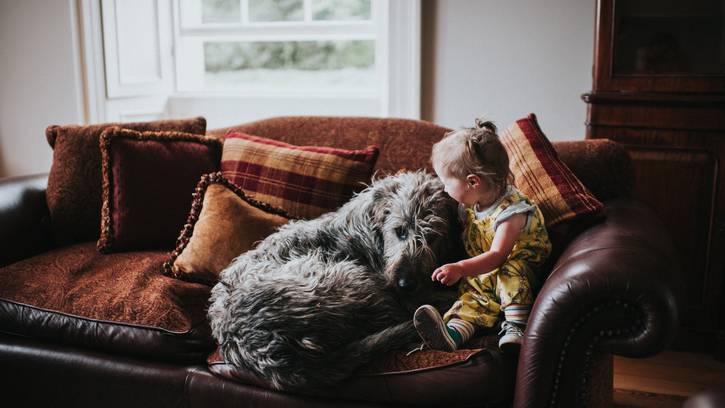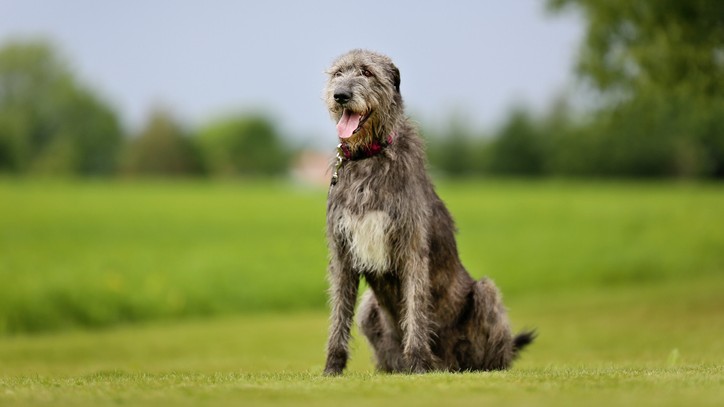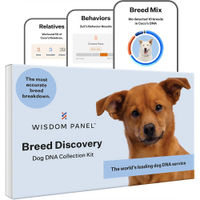Irish Wolfhound: Breed profile
The Irish Wolfhound isn't just big in stature; he's a big-hearted softie who's completely loyal to his owner

Let's get the most important thing out of the way from the start: just how big is this breed? When fully grown, an Irish Wolfhound will tower above your kitchen worktops, look children in the eyes and have people staring at you in the streets when you take one for a walk!
But then they are the largest breed of dog in the world, standing at a minimum of 30 inches (76cm) for a female and 32 inches (81cm) for a male. And note the word “minimum” there!
As such, this sighthound can look a little fearsome but should you be scared when you spot or even end up caring for one? Not a bit of it. This breed – dating back to ancient Rome – is often called the gentle giant and it gets on very well with humans. Their days of pulling people from horses and chariots during wars are now, thankfully, long gone.
What you get today is a large, quiet, laid back dog with a big heart that needs walks but is more than happy to chill. The main concern is that these sighthounds were bred to hunt and still like to chase prey but you can take precautions against that.
How much exercise does a Irish Wolfhound need?
Life expectancy: 6-8 years
Average weight: Male: 180lbs/82kg Female: 140lbs/64kg
About the same as: An average man
Irish Wolfhounds often give the appearance that they're more than happy lazing around but exercise is still vitally important for this breed. As adults, they'll need at least two hours of exercise each day, ideally spread across two or three sessions but if you take care of an Irish Wolfhound as a puppy, you must be much more careful: don't take them for walks if they are aged six months or less or you'll likely cause damage to their fast-developing joints and bones and, after that, start building up the exercise regime gradually. Getting the right balance isn't easy.
As well as walks, during which an Irish Wolfhound must always be on a leash, this breed's exercise should include playtime. Ideally, you'll have a large fenced-off yard in which they'll be able to run, free from worry that their natural prey instinct will kick in. You should also get involved during these sessions, preferably with the help of the best dog toys which will mentally stimulate them. Don't forget to give them time to explore their environment too and maybe keep exercise confined to the great outdoors. You don't want really want an Irish Wolfhound darting around your home, sending your TV hurtling to the floor!
Are Irish Wolfhounds easy to train?
Suitable for: Anyone who wants a large, gentle dog
Not suitable for: Anyone living in a small home
Temperament: Sweet-natured, loyal, sensitive
Shedding: Low
You shouldn't have too much trouble training an Irish Wolfhound but the key to success lies in how you approach the sessions. They are sensitive dogs so you need to be encouraging, heaping them with praise and giving them tasty treats for a job well done. At the same time, you need to be patient and consistent while getting them used to their new environment. Socialize them early and you'll avoid many problems later on – no-one wants a large, unruly dog in their home, after all!
Since Irish Wolfhounds are naturally clean, house training is largely straightforward. You'll also find that they are intelligent and will quickly understand what you're asking of them so you don't necessarily need to use endless repetition to get your intentions across. As you train, bear in mind that they're going to struggle to hear their recall if they've decided to give chase so keep them free from such distractions. And if you do feel frustrated and believe that training your Irish Wolfhound feels like a near-impossibility, take stock: this breed will want to please you and they'll form a very strong bond.
Are Irish Wolfhounds good with kids?

Yes. Irish Wolfhounds are gentle giants and if you socialize them from a young age, they'll get on really well with children. Yet because they are so large, your main concern will be that they accidentally bump into a kid and injure them, more so if you have toddlers around the house. You will also need to make sure that a child is never tempted to ride or even simply sit on an Irish Wolfhound's back: this can cause severe injuries. Encourage children to sit next to them instead and ask them to refrain from playing games that are too rough.
What do Irish Wolfhounds eat?
As you may have guessed, Irish Wolfhounds need more food than most dogs and you need to aim as many as eight cups of high quality dry dog food each day, spread over two meals (aim for less volume when feeding puppies, perhaps over three meals).
Just be careful about overfeeding – obesity will put pressure on an Irish Wolfhound's joints and bones – and don't take them out for exercise within an hour before feeding them or two hours after they've eaten. Doing so can increase their chance of Gastric Dilation Volvulus, or bloat, which is a common and potentially deadly ailment in this breed.
Do Irish Wolfhounds bark a lot?
Not really. Irish Wolfhounds are actually one of the quietest dog breeds and a tad introverted to the point that they'll barely raise a grumble if they spot someone coming up the driveway towards your house. Good guard dogs, they ain't – unless you're relying on someone spotting their size and running a mile, that is. If they do bark, however, then you'll certainly know about it because it's rather loud. At that point, you should investigate why they're doing it because it will indicate something they're really not happy with.
Are Irish Wolfhounds aggressive?

Not at all – well, certainly not around humans. That's why they are known as gentle giants and their sweet nature is sure to win you over. Even so, you need to wary when they're in the company of animals. They'll be fine around other dogs and they'll tolerate your own cat but they will see many other animals as fair game for a chase. And if they do get an animal in their sights, then you're going to have trouble controlling them given their size, weight and single-minded focus.
Do Irish Wolfhounds shed a lot?
Amount of shedding: Low
Easy to groom: Yes
General health: Good
Potential for weight gain: Low to moderate
A wiry haired dog breed (and one of the biggest dogs with beards!) Irish Wolfhounds shed an average amount of hair but it's consistent throughout the year. As such, they will only require semi-regular brushing, maybe just once or twice a week, to remove any excess hair and dirt. You won't need to bath them much either, getting away with once every six months as a minimum. Otherwise, just keep their nails trimmed and their teeth clean and check their body for any parasites or signs of infection.
Wisdom Panel Breed Discovery DNA Kit | Amazon
Not sure exactly what breed your dog is? This kit screens for 365+ breeds – because knowing every detail about your dog helps you understand how best to care for them.
Irish Wolfhound health problems
Sadly, Irish Wolfhounds do not have a long lifespan but, in general, they don't have too many specific health issues. The biggest problems such as bloat or damage to joints and bones can be avoided by taking extra special care (see the advice above) but that can heap responsibility on an owner. Other than that, the main things to watch out for are cancer, heart disease and a developmental disorder called portosystemic shunt caused when toxins, proteins and nutrients that are absorbed by the intestines end up in the systemic circulation having bypassed the liver. These can emerge early in life.
Should I get a Irish Wolfhound?
If you have the space (and given their size, you will need it), then you should definitely consider an Irish Wolfhound. Gentle, cute and relatively easy to train, you'll end up with a loyal and loving companion that will fit well into family life and get along with the kids. That said, you may find their short lifespan is too distressing to contemplate: losing your furpal so early is going to be heartbreaking. They're also rather expensive both to buy and to care for.
Want to learn more about this breed? Here are our favorite Irish Wolfhound facts
PetsRadar Newsletter
Get the best advice, tips and top tech for your beloved Pets

David Crookes has been a journalist for almost 30 years and he has written for a host of magazines, newspapers, websites and books including the World of Animals Annual, BBC Earth, Live Science, The Independent and Tom’s Guide.
Born in England, he lives with two cats but he’s also keenly interested in the differences between the huge number of dog breeds – in fact, you can read many of his breed guides that he’s written in collaboration with vets here on PetsRadar.
With a lifelong passion for technology, too, he’s always on the lookout for useful devices that will allow people to keep their pets happier and healthier, and provide them more time to spend together.
David has a degree from Durham University, as well as postgraduate diploma in journalism from the University of Central Lancashire.

